When you’re about to make a purchase, what gives you confidence that you aren’t making a terrible mistake? What convinces you that the product on the screen or in your hands is going to change your life the way you hope?
Nearly everyone looks to others for that confidence. To avoid the dreaded buyer’s remorse, we seek validation from people we trust. This is true whether you’re an individual or a company.
This phenomenon of seeking validation from those around us is called social proof. Social proof has become increasingly critical for marketing. It’s often confused with user-generated content. But they aren’t precisely the same.
In this article, we’ll help you compare user-generated content vs social proof, plus:
- understand why social proof is important for marketing,
- become familiar with the different types of social proof, and
- think of ways to get user-generated content.
Comparing User Generated Content vs Social Proof
Let’s start defining each term. User-generated content (UGC) is any content created by consumers rather than brands. This content could be text, videos, images, reviews, etc.
Social proof, on the other hand, is a phenomenon in which a person’s behavior is influenced by the people around them.
Are UGC and social proof the same thing? Not exactly. The goal of UGC is social proof. In other words, UGC acts as social proof when consumers see that your product/service is worth buying.
Why does this happen? Because consumers see or hear other consumers endorsing the product.
Consumers tend to trust other consumers more than a brand or influencers. Companies do the same with other companies.
It’s not that brands are inherently untrustworthy. It’s that we expect brands to tell us how great these products are (they made them, after all). It’s the same for influencers. We know influencers benefit from commissions. Consumers are less likely to take brands and influencers at their word.
This is why social proof is critical for your content marketing strategy.
A Very Brief History of Social Proof
Before we dig deeper into why that is, let’s ask: where did social proof come from?
In a way, social proof has been around since the dawn of time. As long as humans have lived in communities, they’ve sought validation for their behavior. Then, depending on the response, they change their behavior to match what’s going on around them.
 Source
SourceAs a specific theory of what persuades people, however, it’s only about four decades old. The term “social proof” was coined by Robert Cialdini in his 1984 book Influence: Science and Practice. The concept is also called “informational social influence.”
Cialdini set out to discover what persuaded people toward one thing or another.
One of the most significant aspects that affected behavior was the influence of others. What Cialdini found is that we tend to copy people we want to be like or be associated with.
Why Social Proof Is Important for Marketing
All of this has a profound impact on your content marketing.
The statistics don’t lie. On average, people read ten reviews before making a purchase.
A whopping 92% of consumers will not purchase a product because of negative reviews. Some research even indicates that one negative review will keep some people from buying.
Just five product reviews can increase conversions by up to 270%.
It can be difficult to remember, but the consumers who buy from you aren’t numbers on a spreadsheet or robots who can be programmed. They are real people who have needs, desires, and expectations.
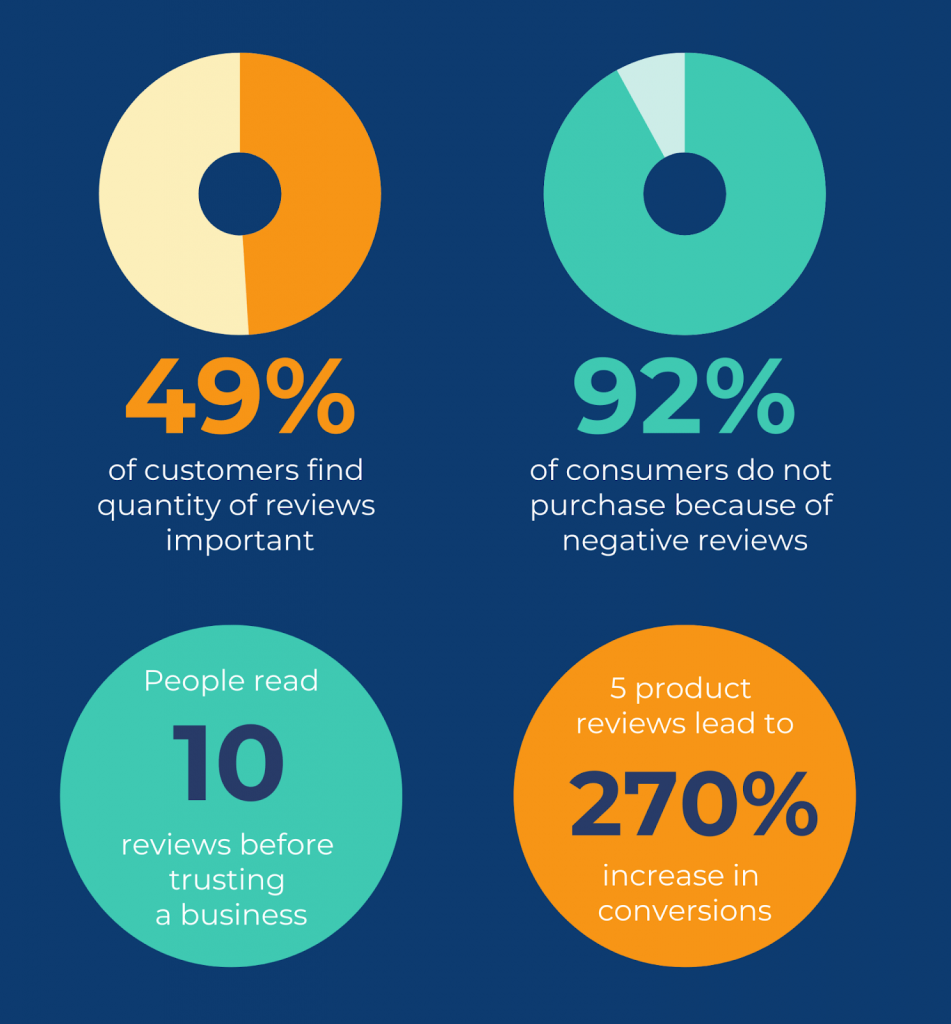 Source
SourceWith that in mind, here are three reasons social proof is important for marketing.
1. Social Proof Makes Your Brand Stand Out
The marketing world is busy and noisy. Some studies show that millennials see around 10,000 messages a day! Consumers are more likely than ever to use an ad blocker or skip videos on their social feeds. Seeing other consumers–who are like them–post about how your product made a difference in their lives is a different story and will get the attention you want.
2. Social Proof Fuels Belonging
People want to do what others are doing. Remember when you did that crazy thing as a kid you would never do today because all your friends were doing it? It’s why you’re more inclined to buy a book that’s on the New York Times best-seller list. Everyone’s doing it! Social proof meets a core need of humanity: belonging.
3. Social Proof Conveys Credibility and Trust
People and organizations don’t make purchases just because everyone is doing it. They purchase because you’ve built credibility and trust with them. When you can convey trust through expert endorsement, dozens or hundreds of positive reviews, testimonials, or case studies, consumers will be more likely to do business with you.
Six Types of Social Proof (with Examples)
There are six types of social proof that marketers use. You may choose one type to be your go-to. Your specific industry and goals will inform which type of social proof will give you the biggest bang for your buck.
1. Reviews
Customer reviews are unique in that they are both user-generated content and social proof. On their own, however, reviews are just mere opinions. Reviews become social proof when you use them for your benefit, particularly on your website.
Hostinger is a web hosting that has a simple, sleek section on its homepage with its top reviews. The heading “Hosting Services Trusted by Thousands” catches your eye. Then you see that they average 4.5 stars based on over 10,000 reviews. Instant social proof.
When you start to accumulate hundred and thousands of reviews, it becomes the number one way for you to social proof your brand. But remember what we said above. Even with just five reviews, your conversions can dramatically increase!
Remember, since the majority of consumers read ten reviews before buying, your website’s review page must be SEO-ready. That way, as people search for reviews for your product or service, you’ll see an improvement in your organic search results.
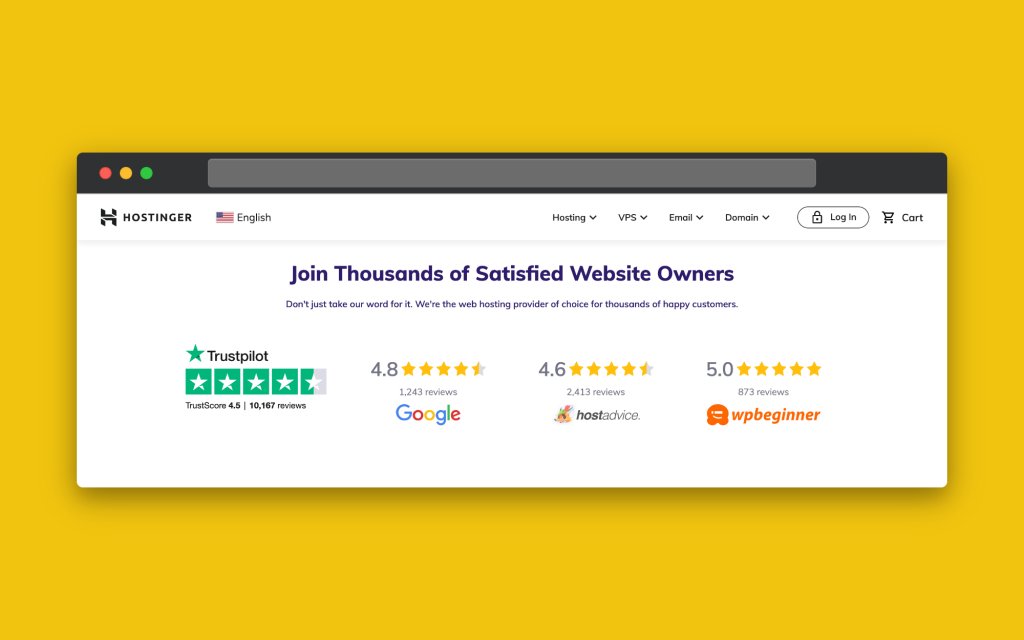 Source
Source2. Case Studies
Case studies provide data-rich, in-depth analysis of how your product or service solved the problem for your customer. Use case studies if you’re marketing B2B software, financial services, manufacturing, or any technical field.
Zeffy is an online fundraising solutions company that helps non-profits keep more of their donations. They call their case studies “Success Stories,” which is a whole lot more appealing.
These stories showcase clearly how they save money for organizations compared to their competitors. Case studies are an excellent way to stand out in a competitive market. Zeffy’s largest competitor is PayPal. But their stories show how they help smaller organizations in ways PayPal can’t.
The idea behind case studies is that when consumers identify with the client’s story, they begin to see themselves as the next potential success story.
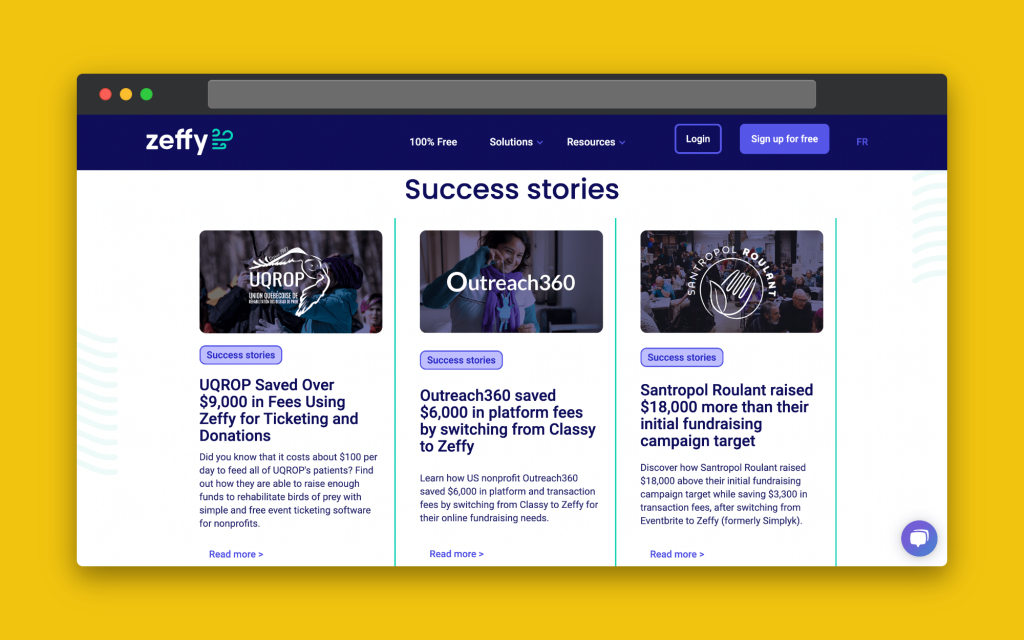 Source
Source3. Testimonials
Testimonials are the nice things your customers say about you and your product or service. It’s their chance to brag on you. Once again, they overlap in that they are user-generated but also serve the purpose of social proof.
You can plant these right on your home page, a landing page after they get your free eBook, or a thank you page for purchase.
Statamic is a software company that helps web developers make websites. They list a few testimonials on their homepage. They also have a whole page called “Customer Stories” devoted to these short recommendations.
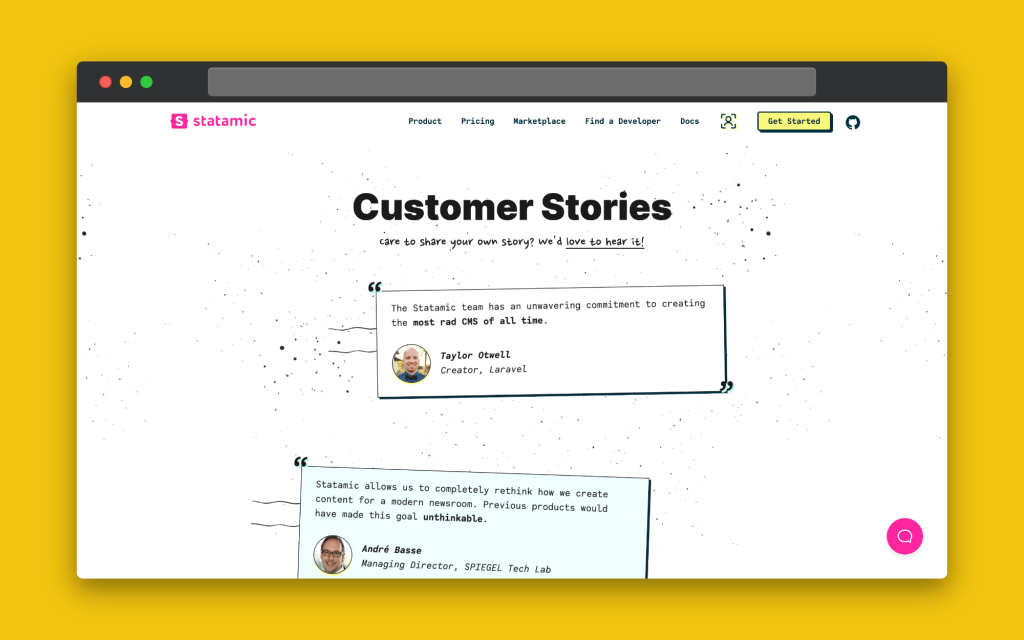 Source
Source4. Social Media
Similar to reviews, social media is user-generated content that also acts as social proof. Your brand will receive praise and recommendation from posts, shares, likes, and comments across Twitter, Instagram, Facebook, and other platforms. Whenever you get a positive comment, save it and share it.
We’re kind of cheating here by showing another testimonial example, but it’s too good not to share. Blue Apron is an ingredient-and-recipe meal kit company based out of New York City. They use Instagram to post a video testimonial from an actual chef using one of their kits. So they get a two-for-one by appealing to an expert in the food industry.
What makes it even better is that his cute dog Olivia is in the video with him. Let the views and likes pour in!
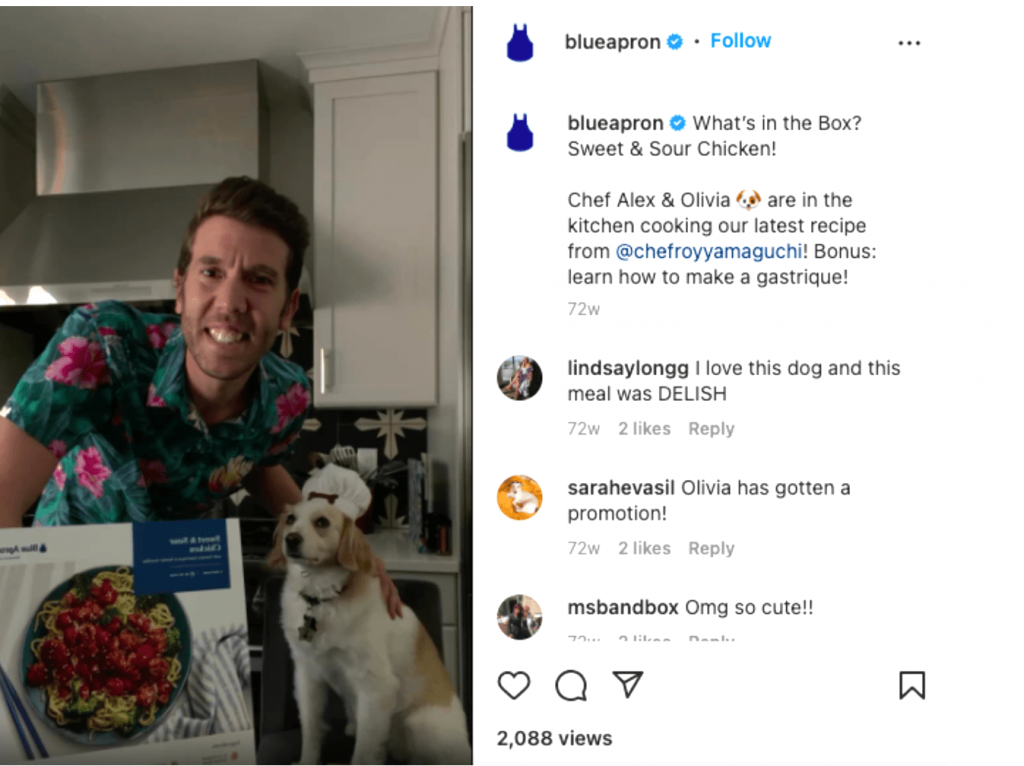
Blue Apron’s Instagram Post
5. Data
Data isn’t just for math geeks. It’s for brands who want to spread the news of their impact. Data means how many customers you’ve served, percent of the market share you own, etc. One number can change the way people see you.
If you combine data with other types of social proofs (testimonials, for example), you’ll be golden.
Here’s an example from WordPress. Chance are, you’ve heard of WordPress. Why? Because 43% of the internet is built on WordPress. Almost half! That’s an absurd statistic. It gives anyone wondering if they should use WordPress the confidence they need to click that CTA to start their website. There’s power in numbers.
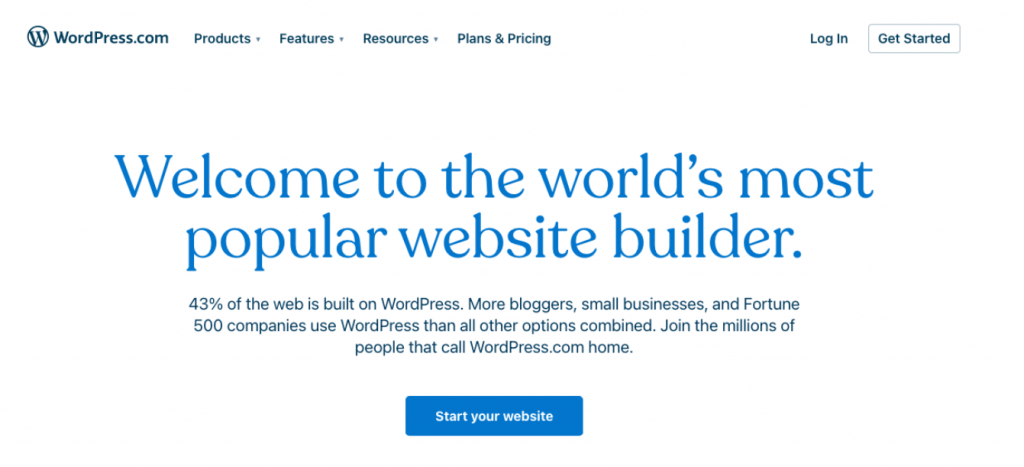 Source
SourceData can work wonders for smaller companies as well. Take Shaked Law– a law firm that wins over clients by drawing attention to the numbers. What numbers?
How much they have won for clients (over $100 million), their combined experience in years (100+), number of cases won (thousands), and number of locations (two!).
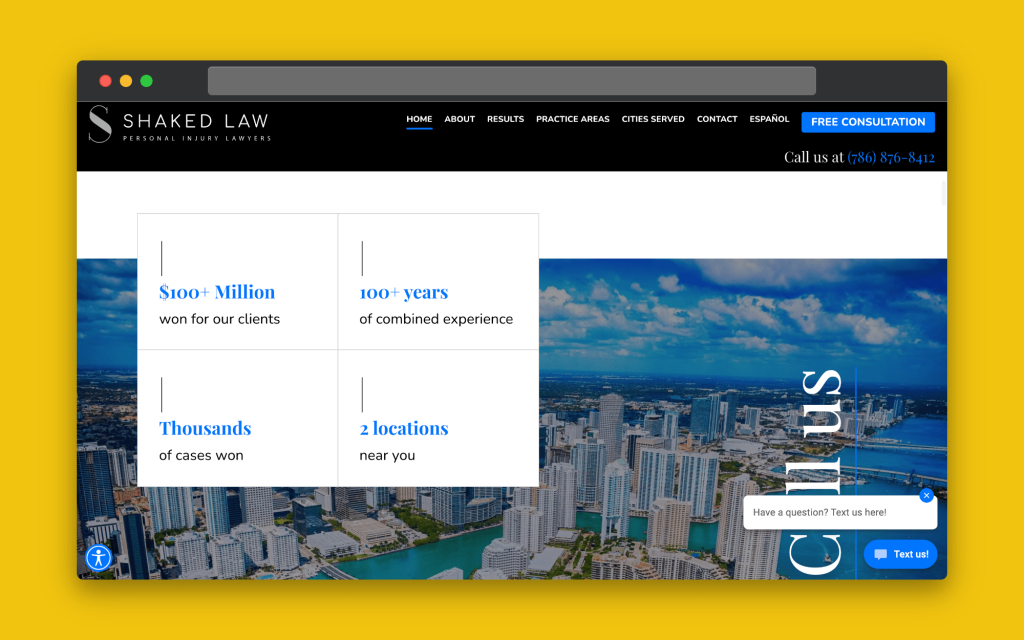 Source
Source6. Trust Icons
Business Insurance USA provides insurance to businesses. On their homepage, they show which insurance companies they partner with. When business owners see big-time brands like Travelers and Liberty Mutual, they know, “Okay, this company is legit.”
Trust icons also help potential clients feel like they’re on the same level as the partners they see on the website. They begin to imagine their logo next to well-known and beloved brands.
Want to take trust icons to the next level? Share what these companies have said about their partnership with you. You can do this on a specific page (like a movie or book landing page) or on your home page.
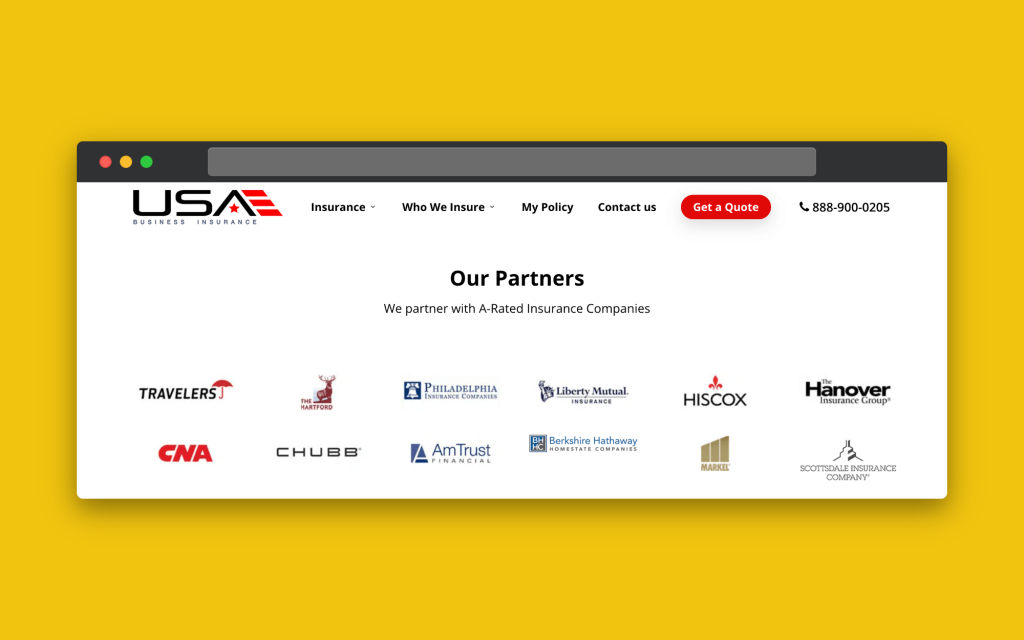 Source
SourceThree Quick Ideas to Get User-Generated Content
We’ve shown that you don’t have to pit user-generated content vs social proof in your marketing strategy. And we’ve shown you several social proof examples.
But what do you do if you’re struggling to get user-generated content yet? Here are four quick ideas to help.
1. Ask for Feedback
One of the easiest ways to get user-generated content to create powerful social proof is through email surveys. The goal is to create something simple that allows your customers to give feedback.
Consider starting with a simple two-question survey. Ask, “How has ______ improved your life?” and “Why did you choose ______over our competitors.”
If you’re not already doing email marketing, you’re missing out on the gobs of UGC. Start by looking at some great cheap email marketing options, and then get that feedback!
2. Create Hashtags
Hashtags are not dead! On social media, hashtags are powerful tools to help spread the word about your brand and a product or service. Hashtags are especially effective on Twitter and Instagram.
When you create a unique hashtag, you can track posts to see what people are saying about your brand or specific products. When people talk about you positively, share it and thank them. It’s also an opportunity to reach out to them privately to ask if they’d write a longer testimonial or review.
3. Build an Online Community
Many people follow you on social media because their friends do (social proof!). In other words, they are there for the community. So use that basic need they have to your advantage.
Host a Facebook Live, an Instagram Live, or a Twitter Spaces chat. Talk about an important aspect of your brand. Then be ready to ask questions or post a poll. Ask how your brand or product has made a significant impact on their lives.
Caution: be ready for negative responses and deal with them appropriately!
Another benefit of building an online community is it fuels more referrals. As you get the word out there more and create brand evangelists, it will, by default, attract more referral customers.
4. Host a Contest
Running a contest can get your brand noticed. When you host a contest (or even a giveaway), you’ll increase the amount of UGC. The content quality should also increase as long as the contest is worthwhile and the prize is enticing.
One type of contest is a “product in action” context. Apple’s famous “shot on iPhone” campaign is a great example. It generated enormous amounts of UGC in the form of photos. You likely won’t get the same volume of responses. That’s okay! It will still generate buzz in your space.
Wrapping It Up
Social proof is one of the most powerful marketing strategies you can use. As you learn how to incorporate social proof in your marketing, you’ll start to see a dramatic increase in leads and conversions. As you examine your brand and industry, think hard about which type of social proof fits you best, and then go all in!
Looking to get started?
If you want to add a little social proof to your website but have no design experience, why not try Xara’s social proof templates?
Start creating for free!

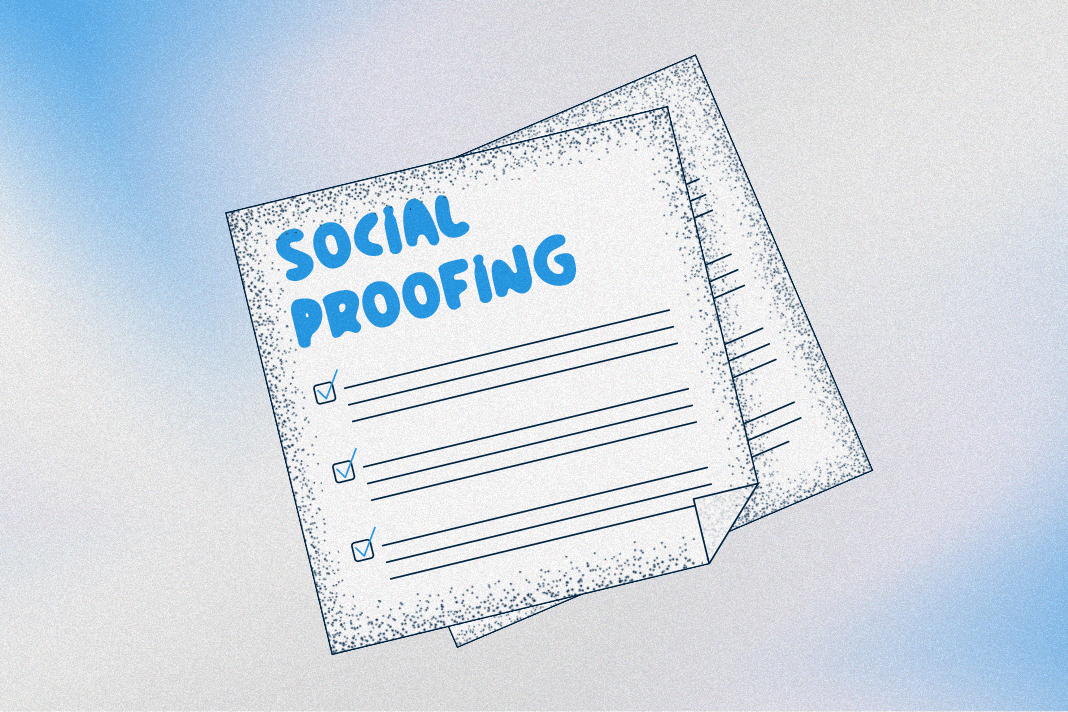

 No credit card or phone number required.
No credit card or phone number required.